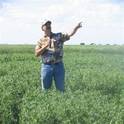
Presentation
Termination Timing and Biomass Removal: Impacts on Soybean Systems
Agronomy Conference Proceedings and Presentations
Document Type
Poster
Disciplines
Publication Date
1-1-2015
Conference Title
ASA-CSSA-SSSA Annual Meeting
Conference Date
November 5-8, 2014
Geolocation
(33.7700504, -118.19373949999999)
Abstract
Iowa often has extreme weather events in the spring, a time when few fields in the state have a living cover, leading to nutrient leaching and erosion issues. These intense rain events also lead to excess soil moisture and runoff. While cover crops help address these issues and more, there has been little adoption of cover crops in Iowa (less than 1% of farmed acres). A commonly cited worry is that cover crops aren't worth the money that a farmer must invest. To offset costs, some farmers use their cover crops for haying or grazing, but a major constraint is access to federal crop insurance for main crops. To address this, an experiment was designed to determine whether the USDA RMA cover crop haying and grazing guideline date (May 10) had an influence on soybean grain yields in Iowa. A replicated plot study was conducted near Ames, Iowa during the 2012-2013 and 2013-2014 growing seasons to investigate the effects of cover crop species, termination date and residue removal on subsequent soybean grain yield. Cover crop entries included Secale cereale ‘Spooner’, Brassica napus ‘Sitro’, Camelina sativa ‘Bison’, B. rapa ‘Purple Top’, and a no-cover crop control. The first year of the study found the only factor with a statistically significant effect on yield was aboveground biomass removal. Plots with biomass removed yielded 3818 kg/ha compared to 3668 kg/ha where biomass was left in place. Cover crop species also had a significant effect on weed pressure and accumulated biomass, carbon and nitrogen. Removal and use of aboveground biomass could serve as a powerful argument to help increase farmer adoption of cover crops.
Rights
Works produced by employees of the U.S. Government as part of their official duties are not copyrighted within the U.S. The content of this document is not copyrighted.
Language
en
File Format
application/pdf
Citation Information
Timothy Sklenar, Andrew W. Lenssen, Mary H. Wiedenhoeft and Thomas C. Kaspar. "Termination Timing and Biomass Removal: Impacts on Soybean Systems" Long Beach, CA, United States(2015) Available at: http://works.bepress.com/andrew_lenssen/112/

This poster was presented at the ASA-CSSA-SSSA Annual Meeting, Long Beach, CA, November 2-5, 2014.